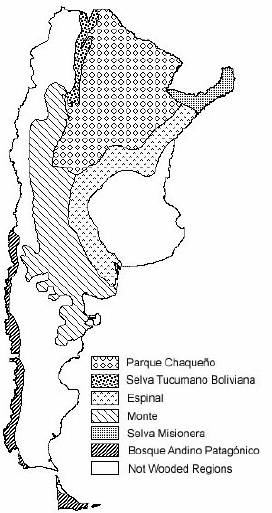


A priority activity for FAO in forestry is the Regional and Global Forest Resources Assessment, FRA. Available data on forest cover, types of forests and other data on the state of forests are collected on country basis, or preferably on sub national basis, to be components of Regional and Global Analysis of the world forests.
For the last Regional and Global FRA the source for the Argentinean forest statistics, IFONA 1987, originated from 1986 and presented a native forest cover of 34.530.000 ha and from this source FRA estimated a native forests coverage of 33.394.500 ha in 1995. The forest statistics in IFONA 1987 were based on various partial forest inventories from different years using different terms and definitions. These inventory results were compiled without any distinction regarding terms and definitions used in the different inventories, meaning that the source for this reason and others is of low precision and therefore not reliable to be used directly in the FRA 2000. It was decided that for the coming FRA (2000) a new effort should be made to achieve more updated data to improve the quality of the new regional and global FRA analysis.
Current Argentinean native forest statistics (Appendix 1) are based on estimations made in 1989 from provincial inventories and reports, satellite interpretations and a preliminary appraisal on the national forests (Montenegro, 2000). Updated forest statistics will be presented through an ongoing national forest inventory for native forests and protected areas, but data from this inventory are still not available except for the region of Misiones (SDSyPA, 2000).
Concerning forest plantations, there is also an ongoing national inventory, but data available at the Ministry of Agriculture, Livestock, Fishery and Food regarding plantation areas are based on provincial information presented by planted tree species and province. The plantation statistics are given annually from 1992 until 1998 and the total area planted is presented by province for the actual year of estimation, which varies for the different provinces (Corinaldesi 1998, Fern�ndez 1999, Maradei 1999, SAGPyA, 1998).
Two national forest inventory projects have recently been carried out in Argentina: the Forestry Development Project for plantations, and the Native Forests and Protected Areas Project. Both projects were executed by the forest inventory consortium, Consultora Forestal Argentino Canadiense, CAC, consisting of the companies Aeroterra S.A., Simons and Tecsult. The work of the consortium was supervised by the Forestry Divisions at the Ministries of Agriculture and Social Action, respectively. The inventory of forest plantations started at the end of 1997, while the native forest inventory in April 1998. The two projects, finalized by July 2000 and March 2001, are the first national forest inventories ever carried out in Argentina.
As a preparation for the national inventories the extension of the phytogeographical regions of Argentina was revised by the Native Forest Division and the wooded regions specified (Figure 1). The inventories are carried out in different stages according to the climate conditions in the different regions. The regions were assessed and inventoried according to a certain schedule and therefore the results of the inventories were gradually becoming available.

According to time schedule presented in November 1999 the Inventory Consortium CAC, results would be available for the Selva Misionera in March 2000 and for the Bosques Andino Patag�nicos in June 2000. Data covering the Selva Tucumano Boliviana and the Parque Chaque�o would be available by December 2000 and finally data for the regions of Monte and Espinal by September 2000 respectively March 2001. The Regions of Monte and Espinal are characterized by scarce, dry to semidry forest formations with low productivity.
Since the two phytogeographical regions of Monte and Espinal (see Figure 2) would not be covered by the national native forest inventory until the end of year 2000 respectively at the beginning of year 2001 an effort was made to co-operate with the Consortium CAC to urge on the data collection. An advance that was desired to be able to present recent and complete data on the forest cover for the whole of Argentina in the global FRA 2000 analysis.
Figure 1 Phytogeographical regions of Argentina classified according to the National Inventory of Native Forests.
Due to the applied sampling design, it was not possible for the inventory consortium to present data in advance over these two regions without employing extra personal working parallel with scheduled activities. For FRA 2000 it was not feasible to finance this external extra cost, knowing that the regions of Monte and Espinal are the two forest regions of less importance in Argentina. Therefore FRA initiated a study based on visual interpretation of forest cover in a sample of satellite images over the regions of Monte and Espinal to be completed by ground-truthing verifying the visual interpretation.